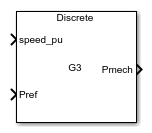Governor Type 3
IEEE type 3 linearized speed-governing hydro turbine model
Libraries:
Simscape /
Electrical /
Control /
Turbine-Governors
Description
The Governor Type 3 block models a model IEEEG3 hydro turbine-governor with penstock dynamics.
This block has a more detailed governor model than the Governor Type 1 block and uses a linearized model of the turbine, or water, column model and penstock dynamics.
You can switch between continuous and discrete implementations of the block by using the
Sample time (-1 for inherited) parameter. To configure the
governor for continuous time, set the Sample time (-1 for
inherited) property to 0. To configure the governor
for discrete time, set the Sample time (-1 for inherited) property
to a positive, nonzero value, or to -1 to inherit the sample time
from an upstream block.
This diagram illustrates the overall structure of the block:

Ports
Input
Output
Parameters
References
[1] Overbye, Tom Power Systems Stability, Lecture Notes. Texas A&M University.
[2] Dynamic Models for Steam and Hydro Turbines in Power System Studies, IEEE Transactions on Power Apparatus and Systems. Vol. PAS-92, Number 6, 1973, pp. 1904–1915.
[3] IEEE Guide for the Application of Turbine Governor Systems for Hydroelectric Generating Units, IEEE Std 1207-2011.
Extended Capabilities
Version History
Introduced in R2020a
